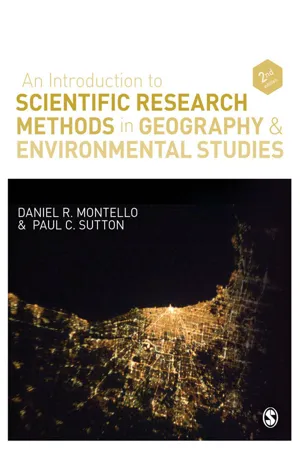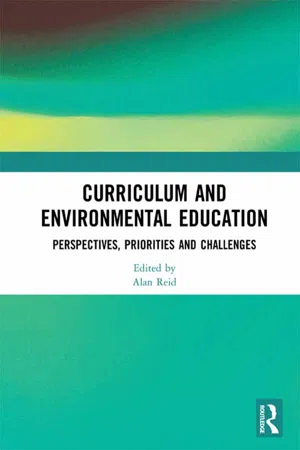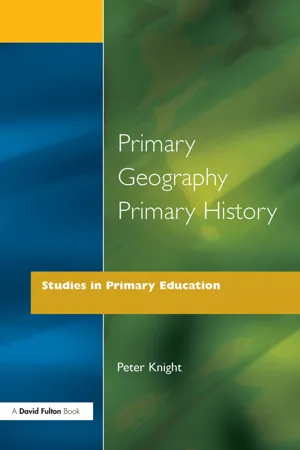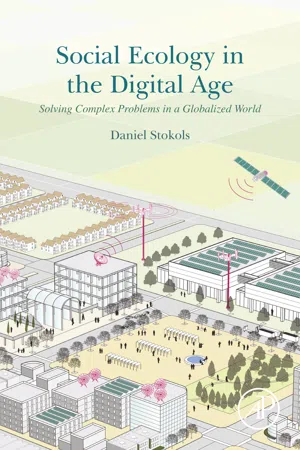Ecological Study
An ecological study in geography examines the interactions between organisms and their environment within a specific geographic area. It focuses on understanding the relationships between living organisms, their habitats, and the physical environment. This type of study provides insights into the complex dynamics of ecosystems and the impact of human activities on the natural world.
6 Key excerpts on "Ecological Study"
- Daniel Montello, Paul Sutton(Authors)
- 2012(Publication Date)
- SAGE Publications Ltd(Publisher)
...Geography is disciplinarily diverse as well, as we have seen, but it does have over a century of history as a unitary academic discipline and much longer as a fundamental component of basic academic training. Both geography and environmental studies have a common focus on earth and environmental topics. That and their mutual multidisciplinarity, especially across the biophysical and social sciences, provides our rationale for a textbook on research methods that integrates geography and environmental studies. Like geography, research in environmental studies looks at earth–sun relationships; biophysical earth systems (Chapter 5) and the cycling of energy and matter through those systems; resources (energy, water, mineral, fisheries, timber, and so on); environmental health and risk (including hazards and toxicology); waste and pollution; climate change; conservation and environmental preservation; population; food and agriculture; land use; urbanization; tourism and recreation; environmental ethics and spirituality; and sustainability. Like geography, environmental studies appreciates that understanding environmental issues must occur within the mutual contexts of space, place, and time. We finish Chapter 1 with a final observation about environmental studies and science. Many people refer to the study of biophysical aspects of environments as environmental science, which, like physical geography, often includes simultaneous consideration of physical, chemical, and biological processes. 12 However, we mostly avoid the term “environmental science” in this book, as one of our fundamental premises is that the social-science research within environmental studies is also environmental science – the scientific study of human–environment relations...
- eBook - ePub
- Robert A. Francis, James D.A. Millington, George L.W. Perry, Emily S. Minor, Robert A. Francis, James D.A. Millington, George L.W. Perry, Emily S. Minor(Authors)
- 2021(Publication Date)
- Routledge(Publisher)
...(2009) Landscape ecology is the study of relationships between spatial pattern and ecological process. McKenzie et al. (2011) Ecology guided by cultural meanings of lifeworldly landscapes. Kirchhoff et al. (2013) Landscape ecology is a transdisciplinary, problem-solving, human ecosystem science. Naveh and Lieberman (2013) A geographic area in which variables of interest are spatially heterogeneous. The boundary of a landscape may be delineated based on geographic, ecological, or administrative units (e.g., a watershed, an urban area, or a county) which are relevant to the research questions and objectives. Wu (2013) There are many appropriate ways to define landscape depending on the phenomenon under consideration. The important point is that a landscape is not necessarily defined by its size; rather, it is defined by an interacting mosaic of patches relevant to the phenomenon under consideration (at any scale). It is incumbent upon the investigator or manager to define landscape in an appropriate manner. The essential first step in any landscape-level research or management endeavour is to define the landscape, and this is of course prerequisite to quantifying landscape patterns. McGarigal (2015) Landscape ecology is an interdisciplinary field of research and practice that deals with the mutual association between the spatial configuration and ecological functioning of landscapes, exploring and describing processes involved in the differentiation of spaces within landscapes, and the ecological significance of the patterns which are generated by such processes. Christensen et al. (2017) Landscape ecology is an interdisciplinary field, drawing on theories and methods from across the physical, natural, and social sciences. Frazier (2019) Landscape ecology is predicated on the assumption that spatial patterns influence ecological processes, and those processes, in turn, feedback to form and alter landscape patterns. Frazier et al...
- eBook - ePub
Curriculum and Environmental Education
Perspectives, Priorities and Challenges
- Alan Reid, Alan Reid(Authors)
- 2019(Publication Date)
- Routledge(Publisher)
...The burden of this argument is in no sense against Environmental Studies as such, but against the tendency of some practitioners to neglect wider perspectives. At the same time, the study of overseas environments should clearly not play so large a role as in Geography courses. In this context, therefore, it is suggested that the difference of approach between Environmental Studies and Geography should be regarded as one of degree and not of kind. In terms of “boundary definition”, however, there is perhaps a more clear-cut distinction between the two, though even this may be greater in principle than in reality in the sense that many practising geographers ignore frontier limitations. Relatively speaking. Geography has narrower terms of reference than Environmental Studies. In the field, for example, the environmentalist is an opportunist who takes what the locality has to offer. Its elements are examined for their own sake; “because they are there”. “Localities have their own processes of selection”, 32 writes Watts. The geographer is more concerned to impose a framework. Hence the environmentalist may study a building as an entity in itself, paying due attention to its architraves as well as its overall architectural style, its historical evolution as well as its present setting. The geographer is more strictly concerned with its site and functional relationships. Contrary to the popular conception that the environmentalist uses the holistic approach in viewing a landscape, he often in fact seems to pay more attention to its minutiae...
- eBook - ePub
- Peter Knight(Author)
- 2013(Publication Date)
- Routledge(Publisher)
...Dominant positions may be identified, and he showed how the geographical hegemony defended itself against the fledgling environmental studies (Goodson, 1983). On this view it is naive to expect consensus of definition not just in geography but in any subject. The possibility remains, however, that geography’s identity crisis is especially acute. Its concern with place is distinctive but not unique, while its concern with the natural world is shared with science, as are some aspects of its concern with the way in which people interact with their surroundings, through farming (agriculture), construction (civil engineering) and pollution (chemistry). With religion, ethics, sociology, political science and history it shares a (moral) interest in human lifestyles. As one synthesis of these subjects geography can be regarded as an integrated study in its own right, as a cross-curricular subject. In summary, four points are worth emphasising. First, we should think not so much of geography as of geographies. We might then expect different views of the subject to lead to rather different educational emphases. Secondly, the view of geography as maps and facts is, on any reckoning, a narrow misrepresentation. Thirdly, geography does not look very much like a subject, in the sense that Hirst (1965) defined a subject, but it is a well-established and productive field of study. Fourthly, it follows that geography draws upon and integrates other subjects: the geographer is a multi-disciplinary person. As a boundary-breaking subject, and as a bridge between the natural sciences and the arts, geography has a distinctiveness...
- eBook - ePub
Ecologies Design
Transforming Architecture, Landscape, and Urbanism
- Maibritt Pedersen Zari, Peter Connolly, Mark Southcombe, Maibritt Pedersen Zari, Peter Connolly, Mark Southcombe(Authors)
- 2020(Publication Date)
- Routledge(Publisher)
...To consider an interior, building, site, or larger landscape as a static, separate entity is to remove it from the world that enlivens it, and neglect or even destroy opportunities for human living that is a part of, not apart from a constantly changing living world. These seemingly separate entities are parts of ecologies that are continuous in both time and space. They are interrelated, connected to, and part of a single larger living realm: that of Nature or the planet Earth. Humans are dependent on, affected by, affect, and are part of this realm, rather than simply observers and manipulators of it. As professionals of the built environment our actions have significant consequences both individually and collectively. Nature as resource and the Anthropocene ‘Nature’, and with it ecology, is often understood, both technically and in an economic sense, as simply a pool of resources or services for human use. The purpose and meaning of ecology can therefore become reduced to understanding and maximising the eco-technical and financial benefits humans derive from Nature (Heal et al., 2005). Some ecological design concepts and methods explicitly try to avoid this conception of ecology, and the political implications of affirming the economic and technical value of Nature in the contemporary economically rational world should be examined. This view that has been cemented in westernised cultures over the past 500 years (Bosworth et al., 2011)...
- eBook - ePub
Social Ecology in the Digital Age
Solving Complex Problems in a Globalized World
- Daniel Stokols(Author)
- 2018(Publication Date)
- Academic Press(Publisher)
...During the 1960s and 1970s, growing concerns about the depletion of natural resources, environmental pollution, and racial violence in US cities prompted psychologists to give more attention to the broader ecological environment. Environmental and ecological psychology, and the closely related field of community psychology, gained momentum at that time and spawned new lines of research on the behavioral and health effects of larger-scale environments—for instance, studies of apartments, offices, neighborhoods, and schools on their occupants [ 82 – 87 ]. Environmental and ecological psychology diverged in several respects from the earlier laboratory studies of individuals’ reactions to isolated stimuli presented in experimental situations, toward a broader-gauged analysis of the activities that individuals and groups perform in their everyday environments. These larger-scale contexts of people’s day-to-day activities occupied a middle ground between the microlevel stimuli studied in behavioral and perceptual psychology and the macroscale environments (e.g., biomes, communities) emphasized in biological and human ecology. Ecological psychologists generally used field research methods rather than laboratory experiments to study people’s interactions with their surroundings. A pivotal contribution to the development of ecological psychology was Roger Barker and Herbert Wright’s investigation of naturally occurring behavior settings [88]. Their ideas about behavior settings grew from observing children in a small Kansas town over 24-hour periods and recording everywhere a child went and the behaviors he/she enacted in each place. They discovered that children’s behavior patterns were better predicted by knowing which environments they entered than from information about their personal attributes (e.g., friendliness, physical stature)...





